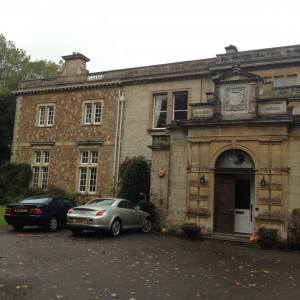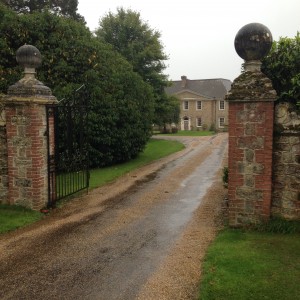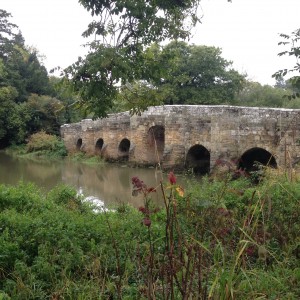
Stopham Bridge. Until the nineteenth century, the Barttelots took it upon themselves to maintain both the bridge and the main road.
Stopham is a tiny parish near Pulborough, in West Sussex. It has fewer than a hundred inhabitants, but reeks with history and has more than its fair share of important buildings.
The River Arun is crossed here by a spectacular fourteenth-century seven-arched stone bridge, with a pleasant pub (the White Hart) at one end, and Stopham House, formerly known as ‘La Ford’, or Ford Place, at the other. Before there was a bridge, the atte Forde family controlled the ferry crossing.
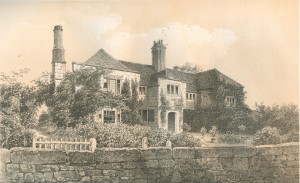
Manor Farm-house is next to the church at Stopham. The Barttelots rebuilt the ancient seat of the Stopham family in about 1485, but abandoned it in 1638 in favour of Ford Place, their house by the river. Apart from the ivy, Manor Farm-house has changed little since this Victorian engraving.
The heiress of the atte Fordes married into the eponymous Stopham family, whose manor-house was adjacent to the eleventh-century church. The eventual heiress of that line, Joan de Stopham, married, in 1395 or 6, John Barttelot, and their descendants – baronets since 1875 – have been squires ever since, including three recent generations of Coldstreamers who have kept the estate in guardsman’s order.
The manor-house is said to have been re-built by the Barttelots in about 1485, but they had abandoned it by 1638, removing everything but its firebacks. Their old home reduced to a farm-house, the then squire, Walter Barttelot, installed his family in the mansion of their female-line ancestors on the riverbank, the former Ford Place, which he, or his father, appears to have modernised.
Undeniably grand and imposing and set in pretty parkland, the Stopham House of today is a singularly ugly confection of rebuilds and additions (1787, 1842, 1865, 1887 and 1898) that conceal within them a hall and some adjoining rooms from the Tudor period. It has been divided into nineteen flats, and the squire has retreated to a more manageably-sized house on the hill, an attractive 1950s pastiche of the Queen Anne style.
The church, abutting the green and a cluster of estate cottages with their distinctive burgundy livery, is positively bursting with Barttelot memorials. The monumental brasses, set into the Sussex-marble floor of the nave and chancel, are the largest and ‘most complete series of sepulchral brasses in the county’. The oldest has portraits of John Barttelot, who died in 1428, and his wife Joan de Stopham. The newest commemorates ‘Captain Charles Barttelot, 1738’. Later generations of Barttelots are never to be forgotten in the marble monuments that cover the walls.
There are also stained-glass windows depicting members of the family and their heraldry, including, on the north wall, a window of three lights, apparently removed from the old manor-house in 1638, on which two of the Stopham lords are depicted in Tudor garb. The White Ensign worn by H.M.S. Liberty, commanded by a Barttelot at the Battle of Heligoland Bight, was laid up here, and so, in 1985, were the regimental colours of the First Battalion the Coldstream Guards, whose commanding officer was the present squire, Colonel Sir Brian Barttelot.
As a Victorian scholar observed, the Barttelots of Stopham have been ‘remarkably stationary both in place and condition’. It is more than likely that they descend from the Norman, Ralph, who held the manor at the time of the ‘Domesday’ survey in 1086. Stopham was one of numerous manors in Shropshire and Sussex granted by William the Conqueror to his close associate, Roger Montgomery. Roger had been keeping the peace at home at the time of the Conquest, but had been rewarded for his patience with the earldoms of Arundel and Shrewsbury. He in turn had distributed various manors among his own followers. Stopham was allotted to one Robert, who sub-let it to Ralph.
The first recorded lords after Ralph are Brian de Stopham (dead by 1236) and his son who, significantly, was also called Ralph. It has been pointed out that Brian de Stopham was a nephew of Brian de Insula or de l’Isle (the ‘isle’ in question being the Isle of Wight), a mighty Norman baron, and that their coats of arms (three crescents and a canton) were identical. At the time of his death in 1271, Sir Ralph de Stopham also held the manors of Bradford Bryan and Blandford Bryan (now called Bryanston) in Dorset, both of which took their names from Brian de l’Isle.
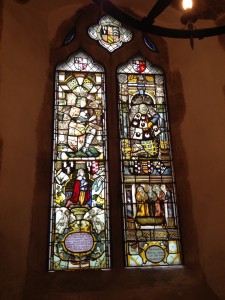
The north window, Stopham Church, with fanciful ancestral portraits. The Barttelots removed it from their old house in 1638
The senior Stopham line ended in an heiress who married William de Echingham. Joan, the eldest daughter and coheiress of William de Stopham and wife of John Barttelot, was no doubt descended from Sir Ralph through a junior line, but it is impossible to prove the connection, pedigrees extending back to that period being in any case a considerable rarity. (C.J. Robinson, ‘Stopham’, Sussex Archaeological Collections, XXVII (1877), pp.37-68; J.H. Round, ‘The Stophams, the Zouches, and the Honour of Petworth’, Sussex Archaeological Collections, LV (1912), pp.19-34; Joan Masefield, Stopham Remembered, Stopham, 1991.)
As for the Barttelots, in spite of the fanciful claims of a sycophantic Elizabethan herald, they were probably of English rather than Norman descent, their name being a diminutive of Bartholomew. They are first recorded at East Preston in 1295 and served successive earls of Arundel as counsellers and men-at-arms. John Barttelot was both Treasurer of the Hospital that Earl Thomas had founded at Arundel and an executor of his will.
His eldest son by Joan, ‘John Bartlett le puysne of Stopham’, was one of the ‘armigeri’ (esquires) who accompanied the earl across the Channel for the Agincourt campaign. Described on 28 September as being on ‘leave’, it is possible that he had contracted dysentery at Harfleur and that he been invalided home with the earl and others of his retinue, in which case he may, unfortunately, have missed the battle. (William Durrant Cooper, ‘Sussex Men at Agincourt’, Sussex Archaeological Collections, XV (1863), pp.127, 129.)
It was said in the fifteenth and sixteenth centuries that the Barttelots could ride from Stopham to Horsham without leaving their own property (Robinson, ‘Stopham’, p.40). If some of this land had indeed been held continuously by their line since the Ralph of Domesday Book, theirs would be a remarkable record of tenure, matched only by the Manners at Belvoir, the Luttrells at East Quantockshead, the Dymokes at Scrivelsby and a mere handful of other families (A.R. Wagner, English Ancestry, Oxford, 1961, pp.28-9). As it is they are the oldest gentry family in Sussex, now that the Pelhams, Wests and Ashburnhams have either died out or relinquished their ancestral estates. It is fitting that the motto of such a family is ‘Mature’.
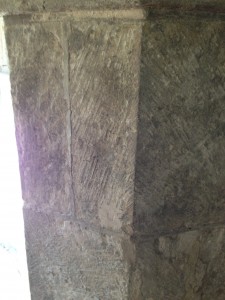
Preparing for their weekly target practice at the butts, the men of the parish are believed to have sharpened their arrows on this pillar at the back of Berwick Church
The Westgates of Berwick. I recently visited the little tucked-away church at Berwick, near Lewes, to inspect Duncan Grant’s lovely murals, but it was the scarred lower stones of the tower arch, at the back of the building, that most caught my imagination. According to St Michael and All Angels, Berwick, East Sussex: A Guide to the Church and 20th Century Bloomsbury Murals that is available at the church, the grooves that pit the stones are ‘thought to have been cut by the sharpening of arrows. Archery practice was made compulsory on a Sunday after church by Edward III. The “Westcatts of Berwick” are on the Rolls of Archers at Agincourt and “Westgates” still live in the parish.’ The humble Westgates would in that case be at least as old as the Barttelots, with an equally long record of continuity in a single place. I note that, 600 years ago last month, a ‘John Wescot’ was an archer in Lord Arundel’s train, John Barttelot’s companion-in-arms (Cooper, ‘Sussex Men at Agincourt’, p.131).
